


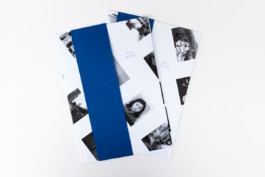
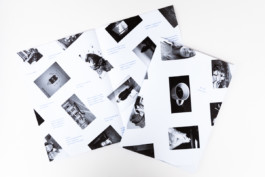
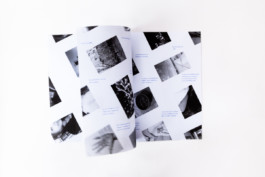
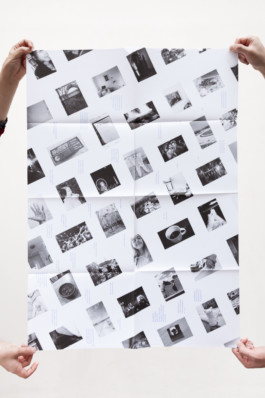
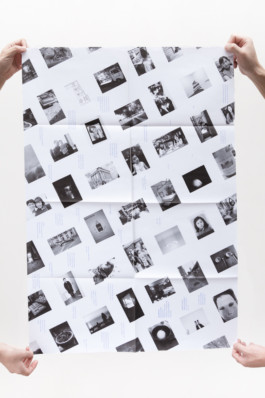
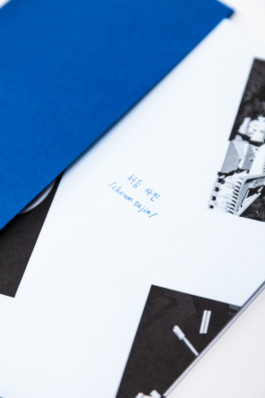
La généralisation des appareils photos sur les téléphones portables a créé un nouveau rapport à la conservation des images. Plus la qualité de l'appareil augmente, plus les espaces de stockages permettent de sauvegarder un nombre considérable de photographies. Il nous paraît normal de prendre jusqu'à plusieurs milliers de photos et de se promener avec elles dans notre poche. Ainsi, au quotidien, toutes ces photos s'accumulent dans nos téléphones. Cette édition voudrait aborder certains rapports que nous entretenons avec les photographies de téléphone, sur le statut et la diversité de ces images et comment les transmettre, immatérielles, sur un support matériel : le livre.
C'est comme cela que ce travail "처음 사진 /choum sajin/" (la première photo), a commencé. On y retrouve la première image, la plus ancienne, du téléphone de 91 personnes : selfie, paysage, photo de famille, capture d'écran, etc. Elles sont très différentes les unes des autres.
En ayant pour seul point commun d'être la première photo sauvegardée dans la galerie du téléphone. Les images se répandent sur le papier en diagonale, sans début ni fin. De fait, dans cette édition, il y a bien une première page et une dernière mais les images se placent sans ordre, sans narration. Chaque image ne cherche pas à être plus que ce qu'elle est, la première photo de certains téléphones portables.
Quand le papier est plié, l'édition se lit comme un livre, où les images s'enchainent entre les textes. Mais celle-ci, une fois dépliée, fait de toutes ces photographies une seule image à laquelle les textes concourrent.
L'édition est imprimé sur un papier de format A0 ensuite coupé en deux. Sur ce papier A0 (84,1x118,9cm) il y a 91 photos misent en place. Une fois le tirage coupé, deux éditions différentes sont crées, chacune de format A1 (59,4x84,1cm). Les abonnées reçoivent donc l'une ou l'autre de ces éditions. Ce choix d'envoyer à nos abonnés deux éditions différentes tirées sur le même papier m'a interessé parce qu'il permettait de respecter l'enjeux du budget de production tout en mettant en forme l'idée que la première photo pouvait se déployer à l'infini.
— Dohyeon Eom
카메라가 내장된 휴대폰의 일반화는 새로운 방식의 이미지 저장을 가능하게 했다. 카메라 성능이 더 좋아지고 핸드폰 저장 공간또한 더 넓어지면서, 휴대폰으로 수천장의 사진을 찍고 그 수천장의 사진을 손 안에 지니고 다니는 것은 당연한 것이 되었다. 우리는 결국 이 기계 속에 쌓여가는 이미지들이 무엇이었는지 조차 잊기 십상이다. 오늘날 휴대폰 사진과 우리들의 관계, 휴대폰으로 사진을 찍는 행위 자체, 그리고 휴대폰 사진의 비물질성과 책에 인쇄된 사진의 물질성에 대한 고민을 이 작업에 담고자 하였다.
그렇게 시작한 책 작업, "처음 사진 /choum sajin/" 은 91명의 휴대폰 안에 저장된 처음 사진으로 이루어져 있다. 셀카, 풍경 사진, 가족 사진부터 스크린 캡쳐 이미지까지. 재미있게도, 이렇게 하나같이 다른 사진들은 각각으로서 독특한 이미지일뿐만 아니라, 모든 사진이 모인 그 집합은 사진들의 다양성을 통해, 전체로서도 하나의 이미지가 된다.
휴대폰 속 첫번째 이미지라는 공통점을 가지고, 사진들은 종이 위에 시작도 없고 끝도 없이 대각선을 타고 비스듬히 흘러 퍼져있다. 그래서 이 책에는 첫번째 페이지와 마지막 페이지는 있지만 책 속 사진들에는 순서가 없으며 서사또한 없다. 그저 각각 모든 사진들이 처음 사진일 뿐이다.
종이가 접힌 상태에서는, 책을 읽듯이, 텍스트를 따라 페이지를 넘기며 텍스트 사이를 흐르는 사진들을 하나씩 관찰할 수 있다. 종이가 펼쳐진 상태에서는, 모든 사진들 전체가 하나의 이미지를 이루며, 그 안에서 텍스트들도 함께 이미지가 된다.
A0 크기 (84,1 x 118,9 cm) 의 종이 위에 91 장의 사진들을 배치해 인쇄하고 반으로 잘라 A1 크기 (59,4 x 84,1 cm) 를 가진 두 권의 책이 나온다. 곧, 구독자들은 각자 두 버전 중 하나의 다른 책을 받게 된다. 이 제작 방식은 제한된 예산을 가진 프로젝트에서 경제적으로도 유리하며, 커다란 종이 위의 "처음 사진"들이 끝없이 펼쳐져 나갈 수 있다는 의미또한 가지게 된다.
— 엄도현
The widespread use of cameras on mobile phones has created a new relationship to the preservation of images. As the quality of the camera increases, more storage space is available to save a considerable number of photographs. It seems normal to us to take up to several thousand photos and carry them in our pocket. Thus, in everyday life, all these photos accumulate in our phones. This edition would like to address some of the relationships we have with telephone photographs, on the status and diversity of these images and how to transmit them, immaterial, on a material support: the book.
This is how this work "처음 사진 /choum sajin/" (the first photo), began. It contains the first and oldest image of the telephone of 91 people: selfie, landscape, family photo, screenshot, etc. They are very different from each other.
The only thing they have in common is that they are the first photo saved in the phone's gallery. The images spread across the paper diagonally, without beginning or end. In fact, in this edition, there is a first page and a last page, but the images are placed without order, without narration. Each image does not try to be more than what it is, the first picture of some mobile phones. When the paper is folded, the edition reads like a book, where the images follow one another between the texts. But this one, once unfolded, makes all these photographs into a single image to which the texts contribute.
The edition is printed on A0 size paper and then cut in half. On this A0 paper (84,1x118,9cm) there are 91 photos set up. Once the print is cut, two different editions are created, each of A1 size (59.4x84.1cm). Subscribers therefore receive one or the other of these editions. This choice of sending our subscribers two different editions printed on the same paper interested me because it allowed us to respect the production budget while at the same time giving shape to the idea that the first photo could be deployed ad infinitum.
— Dohyeon Eom
Photo : La première photo dans le téléphone portable de 91 personnes
사진 : 91명의 핸드폰 사진첩 처음 사진
Photo: The first photo in the mobile phone of 91 people
Concept, Mise en page : Dohyeon Eom
컨셉, 제작 : 엄도현
Concept, Layout: Dohyeon Eom
300x210mm (plié), 840x590mm (déplié)
300x210mm (접었을 때), 840x590mm (펼쳤을 때)
300x210mm (folded), 840x590mm (open)
8p
8쪽
8p
Impression tirage plan
도면 인쇄
Architectural plan print
Éditions tirées en 18 exemplaires numérotés
18부 한정 에디션
Editions printed in 18 numbered copies
Épuisé
절판
Out of Print
Éditions Mensuelles
11/2017






La généralisation des appareils photos sur les téléphones portables a créé un nouveau rapport à la conservation des images. Plus la qualité de l'appareil augmente, plus les espaces de stockages permettent de sauvegarder un nombre considérable de photographies. Il nous paraît normal de prendre jusqu'à plusieurs milliers de photos et de se promener avec elles dans notre poche. Ainsi, au quotidien, toutes ces photos s'accumulent dans nos téléphones. Cette édition voudrait aborder certains rapports que nous entretenons avec les photographies de téléphone, sur le statut et la diversité de ces images et comment les transmettre, immatérielles, sur un support matériel : le livre.
C'est comme cela que ce travail "처음 사진 /choum sajin/" (la première photo), a commencé. On y retrouve la première image, la plus ancienne, du téléphone de 91 personnes : selfie, paysage, photo de famille, capture d'écran, etc. Elles sont très différentes les unes des autres.
En ayant pour seul point commun d'être la première photo sauvegardée dans la galerie du téléphone. Les images se répandent sur le papier en diagonale, sans début ni fin. De fait, dans cette édition, il y a bien une première page et une dernière mais les images se placent sans ordre, sans narration. Chaque image ne cherche pas à être plus que ce qu'elle est, la première photo de certains téléphones portables.
Quand le papier est plié, l'édition se lit comme un livre, où les images s'enchainent entre les textes. Mais celle-ci, une fois dépliée, fait de toutes ces photographies une seule image à laquelle les textes concourrent.
L'édition est imprimé sur un papier de format A0 ensuite coupé en deux. Sur ce papier A0 (84,1x118,9cm) il y a 91 photos misent en place. Une fois le tirage coupé, deux éditions différentes sont crées, chacune de format A1 (59,4x84,1cm). Les abonnées reçoivent donc l'une ou l'autre de ces éditions. Ce choix d'envoyer à nos abonnés deux éditions différentes tirées sur le même papier m'a interessé parce qu'il permettait de respecter l'enjeux du budget de production tout en mettant en forme l'idée que la première photo pouvait se déployer à l'infini.
— Dohyeon Eom
Photo : La première photo dans le téléphone portable de 91 personnes
Concept, Mise en page : Dohyeon Eom
300x210mm (plié), 840x590mm (déplié)
8p
Impression tirage plan
Éditions tirées en 18 exemplaires numérotés
Épuisé
카메라가 내장된 휴대폰의 일반화는 새로운 방식의 이미지 저장을 가능하게 했다. 카메라 성능이 더 좋아지고 핸드폰 저장 공간또한 더 넓어지면서, 휴대폰으로 수천장의 사진을 찍고 그 수천장의 사진을 손 안에 지니고 다니는 것은 당연한 것이 되었다. 우리는 결국 이 기계 속에 쌓여가는 이미지들이 무엇이었는지 조차 잊기 십상이다. 오늘날 휴대폰 사진과 우리들의 관계, 휴대폰으로 사진을 찍는 행위 자체, 그리고 휴대폰 사진의 비물질성과 책에 인쇄된 사진의 물질성에 대한 고민을 이 작업에 담고자 하였다.
그렇게 시작한 책 작업, "처음 사진 /choum sajin/" 은 91명의 휴대폰 안에 저장된 처음 사진으로 이루어져 있다. 셀카, 풍경 사진, 가족 사진부터 스크린 캡쳐 이미지까지. 재미있게도, 이렇게 하나같이 다른 사진들은 각각으로서 독특한 이미지일뿐만 아니라, 모든 사진이 모인 그 집합은 사진들의 다양성을 통해, 전체로서도 하나의 이미지가 된다.
휴대폰 속 첫번째 이미지라는 공통점을 가지고, 사진들은 종이 위에 시작도 없고 끝도 없이 대각선을 타고 비스듬히 흘러 퍼져있다. 그래서 이 책에는 첫번째 페이지와 마지막 페이지는 있지만 책 속 사진들에는 순서가 없으며 서사또한 없다. 그저 각각 모든 사진들이 처음 사진일 뿐이다.
종이가 접힌 상태에서는, 책을 읽듯이, 텍스트를 따라 페이지를 넘기며 텍스트 사이를 흐르는 사진들을 하나씩 관찰할 수 있다. 종이가 펼쳐진 상태에서는, 모든 사진들 전체가 하나의 이미지를 이루며, 그 안에서 텍스트들도 함께 이미지가 된다.
A0 크기 (84,1 x 118,9 cm) 의 종이 위에 91 장의 사진들을 배치해 인쇄하고 반으로 잘라 A1 크기 (59,4 x 84,1 cm) 를 가진 두 권의 책이 나온다. 곧, 구독자들은 각자 두 버전 중 하나의 다른 책을 받게 된다. 이 제작 방식은 제한된 예산을 가진 프로젝트에서 경제적으로도 유리하며, 커다란 종이 위의 "처음 사진"들이 끝없이 펼쳐져 나갈 수 있다는 의미또한 가지게 된다.
— 엄도현
사진 : 91명의 핸드폰 사진첩 처음 사진
컨셉, 제작 : 엄도현
300x210mm (접었을 때), 840x590mm (펼쳤을 때)
8쪽
도면 인쇄
18부 한정 에디션
절판
The widespread use of cameras on mobile phones has created a new relationship to the preservation of images. As the quality of the camera increases, more storage space is available to save a considerable number of photographs. It seems normal to us to take up to several thousand photos and carry them in our pocket. Thus, in everyday life, all these photos accumulate in our phones. This edition would like to address some of the relationships we have with telephone photographs, on the status and diversity of these images and how to transmit them, immaterial, on a material support: the book.
This is how this work "처음 사진 /choum sajin/" (the first photo), began. It contains the first and oldest image of the telephone of 91 people: selfie, landscape, family photo, screenshot, etc. They are very different from each other.
The only thing they have in common is that they are the first photo saved in the phone's gallery. The images spread across the paper diagonally, without beginning or end. In fact, in this edition, there is a first page and a last page, but the images are placed without order, without narration. Each image does not try to be more than what it is, the first picture of some mobile phones. When the paper is folded, the edition reads like a book, where the images follow one another between the texts. But this one, once unfolded, makes all these photographs into a single image to which the texts contribute.
The edition is printed on A0 size paper and then cut in half. On this A0 paper (84,1x118,9cm) there are 91 photos set up. Once the print is cut, two different editions are created, each of A1 size (59.4x84.1cm). Subscribers therefore receive one or the other of these editions. This choice of sending our subscribers two different editions printed on the same paper interested me because it allowed us to respect the production budget while at the same time giving shape to the idea that the first photo could be deployed ad infinitum.
— Dohyeon Eom
Photo: The first photo in the mobile phone of 91 people
Concept, Layout: Dohyeon Eom
300x210mm (folded), 840x590mm (open)
8p
Architectural plan print
Editions printed in 18 numbered copies
Out of Print
© ces éditions 2025